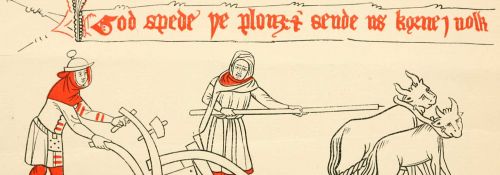
Preserving Manuscripts for Modernity
Written by Madeleine Jepsen
While every Hillsdale student gets an opportunity to read timeless English literature through the Great Books classes, few get a glimpse of the historical process of preserving these manuscripts for modernity. This is exactly what junior Ali Strauss explores as she works with Dr. Patricia Bart on her research.
In the same way a book’s nuanced narrative provides insight into the themes of that work, the details of a manuscript provide insight into the people who transcribed it—their occupation, status in society, and level of education—all of which play into the way they write down the words.
“I love that when we’re reading through this ancient manuscript and making sure we’re understanding what it’s saying, but also why it’s saying that, we’re understanding the story behind it,” Ali said. “You’re learning a lot of the different factors that went into producing the document in front of us. You’re paying attention to very small and seemingly insignificant details. But when you’re doing this kind of thing, it’s those very small errors that are very important.”
Understanding these implications is one of the aims of Dr. Bart’s research, which examines manuscripts of William Langland’s poem “Piers Plowman” in comparison to an electronic archive. Dr. Bart works with a small group of students to ensure that each meaningful detail, which may otherwise be overlooked, is represented in the archive.
Sometimes this involves individual assignments for students. Ali works independently to check different aspects of the archive—that there are no missing words, that the line concordance is preserved, and that other nuances in the text are accounted for. She also works alongside Dr. Bart twice a week, and they go through the manuscripts together.
“Working alongside Dr. Bart is a totally different experience. She is looking at the true photos of the actual manuscript on her computer screen, and she is reading through the actually manuscript out loud in front of me,” Ali said.
Since Ali began working with Dr. Bart on the Piers Plowman Project last year, she has gained insight into the meaning behind the transcriptions of “Piers Plowman.”
“I’ve really enjoyed doing that with her because she teaches me a lot about the language and also about the scribe,” Ali explained. “It turns out he used scrap paper to create one of the most historically significant manuscripts of the ancient English language times. You see a lot of water damage. It’s interesting because the calligraphy and penmanship is so beautiful, but it’s written on low-quality paper.”
As the duo works through the manuscript word by word, line by line, they check that the details in the manuscript are noted in the electronic text. For example, some letters may be italicized, and there may be marks in the margins of the paper, or a word may be crossed out or written over.
“We get a lot done even though she likes to talk and teach me more about the work we’re engaged in. That’s very important to her,” Ali said. “We talk about some things that he did, like mistakes that he made, or things that he did that he didn’t mean to do, or things that he did intentionally that we should take note of that would be easily overlooked.”
To offset the painstakingly detailed work, which can often become monotonous, Dr. Bart emphasizes the importance of taking breaks from the work. Even if it’s just taking five minutes to walk around the hallway and stretch her legs or to make a cup of coffee, Ali explained that the pauses in the work refresh her brain and prepare her to return to the demanding work.
“She tries to make the experience very convivial,” she said. “She wants it to be a joyful experience because it’s really hard work.”
In these moments of rest amid the work, Ali has been able to get to know Dr. Bart outside of the classroom, providing a venue for the sharing of life experience and wisdom.
“During breaks, we are talking,” she said. “I think that’s what makes the job mean something. Dr. Bart and I have a relationship as humans. Dr. Bart, she loves to enjoy life, but she has had a very difficult life. She has an amazing life story.”
Ali recalled a time when one of Dr. Bart’s students had a seizure just before coming to class, and Dr. Bart canceled class, remaining with the student in the hospital until his parents could fly in from California. This is emblematic of Dr. Bart, who goes above and beyond to help students in whatever way she can, providing support both in and out of the classroom.
In fact, that is how Ali first developed a relationship with Dr. Bart—when she went in for office hours for help on an annotated bibliography.
“Because she knew that I wanted to succeed, she was willing to go above and beyond,” Ali noted. “She expects a lot, but she has such a big heart. She really is very selfless.”
As she worked through the research paper, meeting many times throughout the semester, Ali got to know Dr. Bart better, and Dr. Bart eventually asked her to help with the research project.
“It just goes to show how important it is to build those relationships with your professors, because then you know each other as people, and you never know where that will lead.”
Madeleine Jepsen, ‘18, studies biochemistry and journalism. Outside the classroom, Madeleine serves as a reporter and assistant editor for the Collegian. She is also involved in Catholic Society.